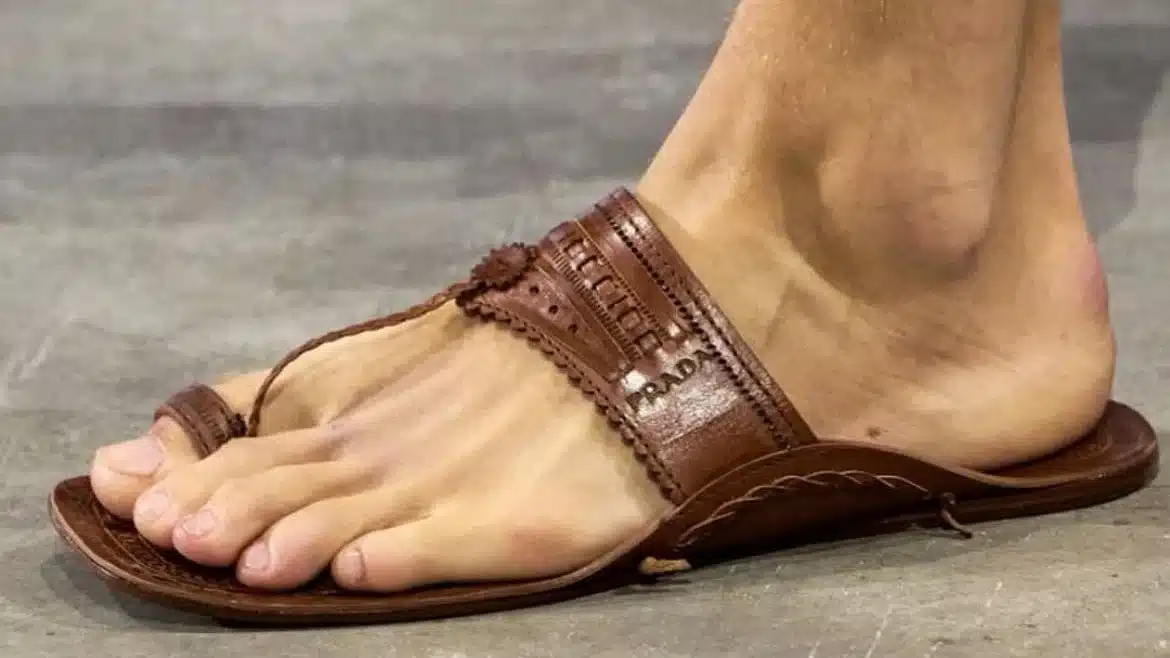Prada-Kolhapuri Dispute: Piyush Goyal Affirms India’s Design Recognition as a GI Product

Union Commerce and Industry Minister Piyush Goyal announced on Saturday that India will receive recognition for its unique cultural products following the recent Free Trade Agreement (FTA) with the United Kingdom. He highlighted the government’s commitment to protecting and promoting Indian cultural products in the global market, particularly in light of the recent controversy involving luxury brand Prada and its use of designs inspired by Kolhapuri chappals. Goyal emphasized that India will receive due credit for its Geographical Indication (GI) products, ensuring that traditional designs are respected and valued internationally.
Government’s Response to Controversy
The controversy surrounding Prada’s Spring/Summer 2026 menswear collection, which featured sandals reminiscent of traditional Kolhapuri chappals, has drawn significant attention. Goyal pointed out that the Indian government acted swiftly when the luxury brand was accused of infringing on GI rights. He stated that the Commerce Ministry took immediate action to protect the integrity of Kolhapuri chappals, asserting that these products are recognized as India’s GI products. Goyal’s remarks underscore the importance of safeguarding India’s cultural heritage in the face of global commercialization.
The Kolhapuri chappal, a traditional Indian footwear style, has significant business potential in international markets, estimated to be worth between ₹8,000 to ₹10,000 crore. Goyal noted that many global brands are eager to collaborate with Indian artisans and promote their products worldwide. This growing interest from international brands reflects a shift towards valuing and respecting traditional Indian craftsmanship.
Prada’s Defense and Legal Implications
In response to the allegations, Prada has denied any wrongdoing. The brand stated that the sandals in question are broadly categorized as “leather sandals” and do not claim any association with the GI-designated region of Kolhapur or its traditional manufacturing techniques. Prada received a ₹500 crore legal notice from LIDKAR, a Karnataka government-backed organization that co-owns the GI tag for Kolhapuri chappals. The notice accused Prada of unauthorized use of GI-registered goods, which could lead to civil and criminal penalties.
Prada’s legal team emphasized that the brand did not use the term “Kolhapuri” or any GI-related tags in marketing or displaying the sandals. The company acknowledged drawing inspiration from Indian footwear but maintained that it did not infringe on any legal rights. This case highlights the complexities of intellectual property rights and the challenges faced by traditional artisans in protecting their designs from global brands.
Expert Opinions on Intellectual Property Rights
Legal experts in India have weighed in on the situation, noting that mere design inspiration does not constitute infringement under current laws. Priyanka Khimani, founder of an intellectual property law firm, explained that borrowing a style without using the GI name in trade does not necessarily violate GI provisions. She stated that unless Prada markets or sells the sandals using the term “Kolhapuri” or implies a connection to Kolhapur’s craftsmanship, there may be no legal recourse available.
This perspective underscores the need for clearer regulations regarding the protection of traditional designs in the context of global trade. As international interest in Indian cultural products grows, it becomes increasingly important to establish robust frameworks that safeguard the rights of artisans and ensure that their contributions are recognized and valued in the global marketplace.
Future Prospects for Indian Cultural Products
The recent FTA with the UK marks a significant step for India in promoting its cultural products on the world stage. Goyal’s comments reflect a broader strategy to enhance the visibility and marketability of Indian craftsmanship. As global brands express interest in collaborating with Indian artisans, there is potential for a thriving market for traditional products like Kolhapuri chappals.
The government’s proactive approach to protecting GI products is expected to encourage more artisans to engage in international trade. By ensuring that Indian designs are credited and respected, the government aims to create a sustainable ecosystem for traditional crafts. This initiative not only supports local artisans but also fosters a greater appreciation for India’s rich cultural heritage in the global market.
Observer Voice is the one stop site for National, International news, Sports, Editor’s Choice, Art/culture contents, Quotes and much more. We also cover historical contents. Historical contents includes World History, Indian History, and what happened today. The website also covers Entertainment across the India and World.
Follow Us on Twitter, Instagram, Facebook, & LinkedIn

